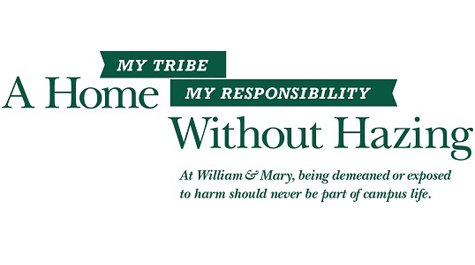Coalition starts hazing-prevention messaging campaign
A coalition of faculty, staff and students at William & Mary is working to prevent hazing on campus, and they are doing so in part with a new messaging campaign.
The “My Tribe, My Responsibility: A Home Without Hazing” campaign kicked off Monday as the university recognizes National Hazing Prevention Week. The main message of the campaign is: “At William & Mary, being demeaned or exposed to harm should never be part of campus life.”
“We think that gives a context that gives lots of people an entry point for talking about hazing,” said Anne Arseneau, director of student leadership development and a member of the coalition.
As a part of their efforts to spread the message throughout campus, the coalition has started a Twitter campaign with the hashtag #WYDTO, which stands for “what you didn’t think of.” Throughout the week, a series of tweets will be sent out with information on what people may not know about the people who experience hazing. In addition, on Oct. 2, W&M will host nationally-recognized speaker Travis Apgar, who will discuss how hazing impacted his life.
The campaign aims to let people on campus know that hazing won’t be tolerated, but also that there are spaces and opportunities to talk about hazing.
“We want to make sure that people feel open and able to talk about it and that they can own it a little bit,” said Linda Knight, director of campus recreation and one of the members of the coalition.
The roots of W&M’s hazing prevention coalition go back to 2007, when William & Mary students participated in a national study. As a result of that study, a coalition was created to coordinate hazing prevention efforts at W&M, with support from the university’s administration. Last year, the coalition launched a reporting form for hazing, and members of the coalition are now participating in the national effort to prevent hazing through organizations like HazingPrevention.org.
This proactive approach to hazing prevention is somewhat unusual for many colleges, said Knight.
“Oftentimes, colleges and universities don’t respond to it until it’s something that’s high-level,” she said, meaning something that results in serious injury.
However, hazing can also include activities that cause humiliation, embarrassment or emotional harm.
What many people aren’t aware of are the “hidden harms of hazing,” said Knight. Students don’t often know the backgrounds of the people that they are hazing, backgrounds that can include things like abuse.
“You don’t know if someone has an alcoholic in their family and then you give them drinks,” said Knight. “To the average person, having a drink isn’t a big deal. But to a person from that family, that could really take them to a very different place.”
Many students who engage in hazing think that they are setting up parameters that will let the people being hazed opt out. However, those students don’t realize that the power dynamic in the situation often makes saying “no” incredibly difficult.
“You’re creating a power differential whether you mean to or not, so you have to be mindful of that,” said Arseneau. “That’s your responsibility as a leader to realize that they aren’t going to be in the position to say no, so don’t even set up the construct.”
Young adults have an inherent, developmental desire to have rites of passage experiences, said Arseneau, and hazing can fulfill that need.
“It makes you feel a part of something,” said Knight. “It makes you feel like you paid your dues to belong, but there are alternate behaviors that can make you feel the same way.”
One of the current goals of the coalition is to provide groups with alternative rites-of-passage behaviors so that students can still fulfill that need but in a healthy way. Another goal of the coalition is reaching out to groups beyond those that are usually targeted for hazing prevention programs, such as sports teams and sororities and fraternities. The coalition also hopes to educate parents, faculty and staff members who may see or hear about hazing incidents.
“We just want to talk about all of these things without it being taboo to talk about hazing,” said Arseneau. “That’s at the heart of it. We want people to feel like there are more opportunities to discuss it before it’s a problem.”
 Skip to main content
Skip to main content

